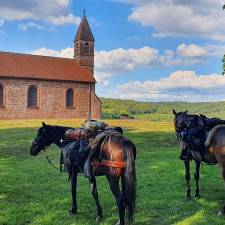Equitopia presents Master Saddle Fitter Jochen Schleese, CMS, CSFT, CSE discussing how to property fit both western and english saddles. Poor saddle fit can cause pain, sheer cartilage from the shoulder blade, cause spinal subluxation and unwanted behaviours. Pressure on involuntary reflex points, such as the side of the withers and behind the saddle support area can cause the horse to stop moving forward and even buck.
In this video excerpt from a demonstration at Equitopia in Fairfield, German Certified Master Saddler Jochen Schleese demonstrates an easy way to check for correct tree angle, simply by using a stick pen!
It is important to ensure the points of the gullet plate in the saddle tree lie flush on the horse’s muscles, in the same angle as the shoulder angle to avoid adding extra pressure at the sides of the withers. The angle of the gullet plate – the tree angle - needs to be parallel to the angle of the shoulder blades. You may notice the shoulders could have different angles because of the natural asymmetry of the horse.
This is the case in 9 out of 10 horses. Where this is so, it is very important that the gullet plate be adjusted to conform to the asymmetry of each shoulder angle. This allows the rotating shoulder blades the freedom for unencumbered backwards/upwards movement during motion – avoiding the tree points.
In effect the shoulder slides freely under the gullet plate. When the shoulder angle is correct, you will notice enough space at the sides near the top of the tree for the withers to contract and shoulders to pass through. If the tree angle is too narrow, or is the same as the angle of the withers (sitting flush on the withers), the shoulder blades will hit the tree with each step.
This is very painful for the horse and can result in irreversible scapular damage if the cartilage cap is chipped off by the gullet plate.
If the tree angle is (incorrectly) adjusted to the wither angle, there is no way the shoulder can pass through; it will hit the gullet plate. If the angle is too steep, the tree will pinch the withers and hit the scapulae.
Several companies have developed measuring tools to determine shoulder and wither angles. The fitted saddle needs to lie within the saddle support area of the horse’s back and the gullet plate needs to accommodate the shoulder angles – which can differ from left to right.
The shoulder angle measurement is that angle between the vertical axis of the horse and the distance to the shoulder blade, as well as the distance between the two shoulder blades (shoulder width). You can only determine how much freedom at the shoulder is actually required by measuring this angle.
Your tack shop should be able to use this shoulder angle measurement to determine whether or not the front panel seam is parallel to the shoulder before you even take out a specific saddle to try.
The saddle should be fitted on site to ensure the gullet plate fits the horse. If the gullet plate is too tight on the one side (because of the natural asymmetry of the horse’s musculature or bone structure) and the angle doesn’t line up with that of the shoulder blade, the result is that the saddle will slip to one side at the back during movement.
The rotation of the shoulder blade and the bigger muscles on the one side will push the saddle out of position if the gullet plate is not fitted to accommodate this.
Jochen Schleese’s mission is to educate riders through Saddlefit 4 Life to protect horse and rider from ill-fitting saddles. Prevent scapular damage by ensuring your saddle provides adequate shoulder freedom. Sign up for your 80 point saddle fit Evaluation to horse and rider.
Saddlefit 4 Life Find solutions for saddle fit issues http://www.Saddlefit4life.com http://www.SaddlesforWomen.com 800-225-2242 Jochen Schleese, German Certified Master Saddler, is author of “Suffering in Silence - The Saddle Fit Link to Physical and Psychological Trauma in Horses” (Trafalgar Books 2013, 2015, 2017) © Saddlefit4Life 2019. All Rights Reserved.
Are you interested in promoting your business or sharing content on EIE? Contact us at info@equineinfoexchange.com











